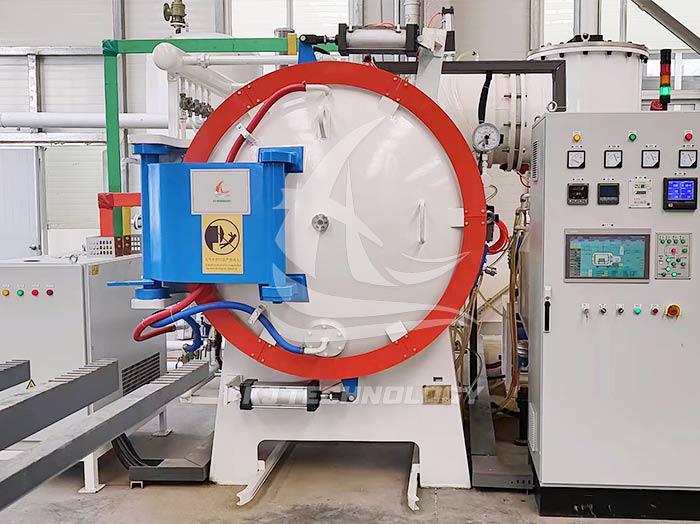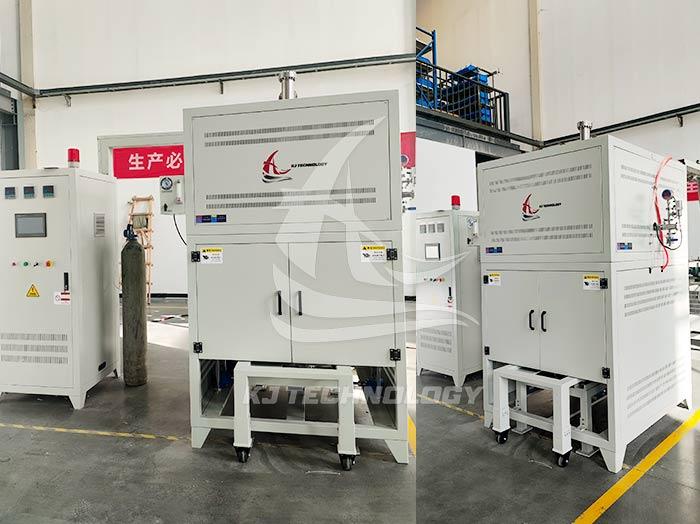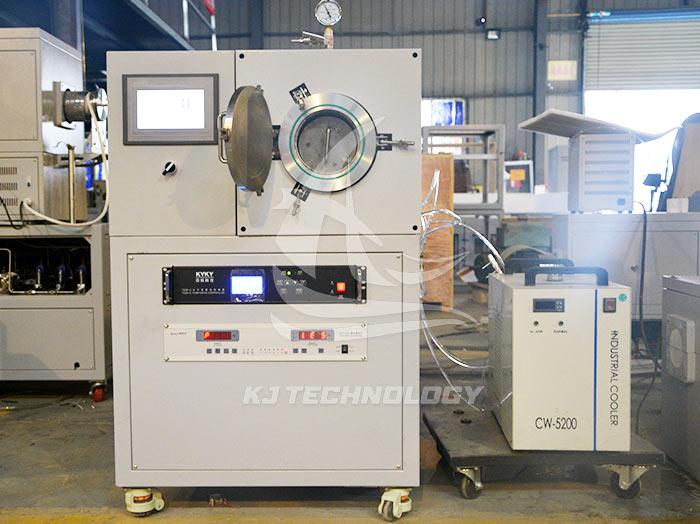Vacuum atmosphere heat treatment furnace
 05-27-2025 Author: KJ technology
05-27-2025 Author: KJ technology
A vacuum atmosphere heat treatment furnace is a high-temperature treatment equipment that combines vacuum technology with heat treatment technology. The following provides a detailed introduction to its working principle, application fields, advantages, characteristics, classification, and other aspects:
1. Working principle
A vacuum atmosphere heat treatment furnace is used to heat treat objects by placing them in a vacuum or specific atmosphere environment at high temperatures. Specifically:
Vacuum environment: Use a vacuum pump to extract gas from the furnace chamber, creating a vacuum environment to prevent the influence of environmental gases on materials and avoid oxidation and other reactions. In a vacuum state, oxygen and moisture inside the furnace are extracted, effectively preventing oxidation and gas reactions, ensuring the purity and quality of the items.
Inert gas environment: Sometimes, in order to prevent materials from oxidizing at high temperatures, inert gases (such as nitrogen, argon, etc.) are used instead of a vacuum environment. The pre treated inert gas forms a protective layer inside the furnace, maintaining the chemical stability of the material and avoiding oxidation. By adding specific gases in an atmospheric environment, different heat treatment effects can be achieved.
Control system: Typically equipped with a microprocessor control system, this system monitors and adjusts the temperature, pressure, and gas flow inside the furnace to ensure that the high-temperature treatment process meets the required requirements and guarantees the accuracy and stability of the heat treatment.
2. Application Fields
The synthesis of new materials provides ideal conditions for the preparation of high-purity compounds. For example, in the crystal growth process of third-generation semiconductor material silicon carbide, the vacuum environment inside the furnace can effectively prevent carbon oxidation, while high temperatures above 1600 ℃ promote the full reaction of silicon and carbon elements, forming uniformly structured single crystals. By adjusting the gas atmosphere ratio, researchers can also achieve doping modification of wide bandgap materials such as gallium nitride, thereby optimizing their electrical properties.
Alloy heat treatment: It is the core equipment for alloy heat treatment. After solid solution treatment in the furnace, the grain size of aircraft engine turbine blades can be controlled at the micrometer level, which increases the fatigue life of nickel based alloys by more than three times.
Photovoltaic industry: The polycrystalline silicon ingot furnace reduces the impurity content of silicon material to below 0.1ppm through staged vacuum pumping and inert gas protection, greatly improving the solar energy conversion efficiency.
New material research and development: provides necessary means for high-temperature synthesis and performance characterization of new materials.
Powder metallurgy: provides a favorable environment for powder sintering and can be used to prepare high-performance powder metallurgy products.
Ceramic material sintering: Ceramic materials need to avoid oxidation during sintering at high temperatures, and vacuum atmosphere furnaces provide ideal conditions for this.
Electronic component packaging: plays an important role.
Optical component processing: It is an important processing equipment.
Metal material processing: Heat treatment processes such as annealing, quenching, and tempering of steel, non-ferrous metals, and their alloys to improve the mechanical properties and service life of materials.
Cultural relic protection: In the vacuum rust removal and stabilization treatment of metal cultural relics (such as bronze ware), corrosion products (such as Cu ₂ (OH) ∝ Cl) are decomposed in a low-temperature vacuum environment (100-200 ℃) to avoid damage to cultural relics caused by traditional chemical treatment.
3. Advantages and Characteristics
High heat treatment quality: almost all conventional heat treatment processes can be achieved, and the heat treatment quality is greatly improved. Compared with conventional heat treatment, it can achieve no oxidation, decarburization, or carburization, remove phosphorus chips from the surface of the workpiece, and have functions such as degreasing and degassing, thus achieving the effect of surface brightness purification.
Small deformation of workpiece: The processed workpiece heats slowly in the furnace, with a small temperature difference and low thermal stress, resulting in small deformation and high product qualification rate, which can reduce costs.
Improving material performance: It has a degassing effect, which enhances the mechanical properties and service life of the workpiece. For titanium and refractory metals, surface hydrogen embrittlement can be prevented.
Good process stability: The vacuum heat treatment process has good stability and repeatability.
Good working environment: safe operation, no pollution or public hazards, and the processed workpieces have no risk of hydrogen embrittlement.
classification
Tube type vacuum atmosphere furnace: usually with a long tube shape, suitable for small batch, continuous or intermittent heat treatment processes. Due to its compact structure, it is commonly used in laboratory research and industrial production.
Box type vacuum atmosphere furnace: With a large furnace space, it is suitable for heat treatment of large quantities or large-sized workpieces. Its uniform heating environment makes the workpiece heated more evenly, and it is commonly used in processes such as annealing and sintering of metal materials.
Horizontal vacuum atmosphere furnace: horizontally placed, suitable for heat treatment of large or heavy workpieces. Its design takes into account the lifting and removal of workpieces, facilitating production operations.
Vertical vacuum atmosphere furnace: vertically placed, occupying a small space, suitable for heat treatment in limited spaces. Its structural characteristics make heat transfer more rapid and uniform.








